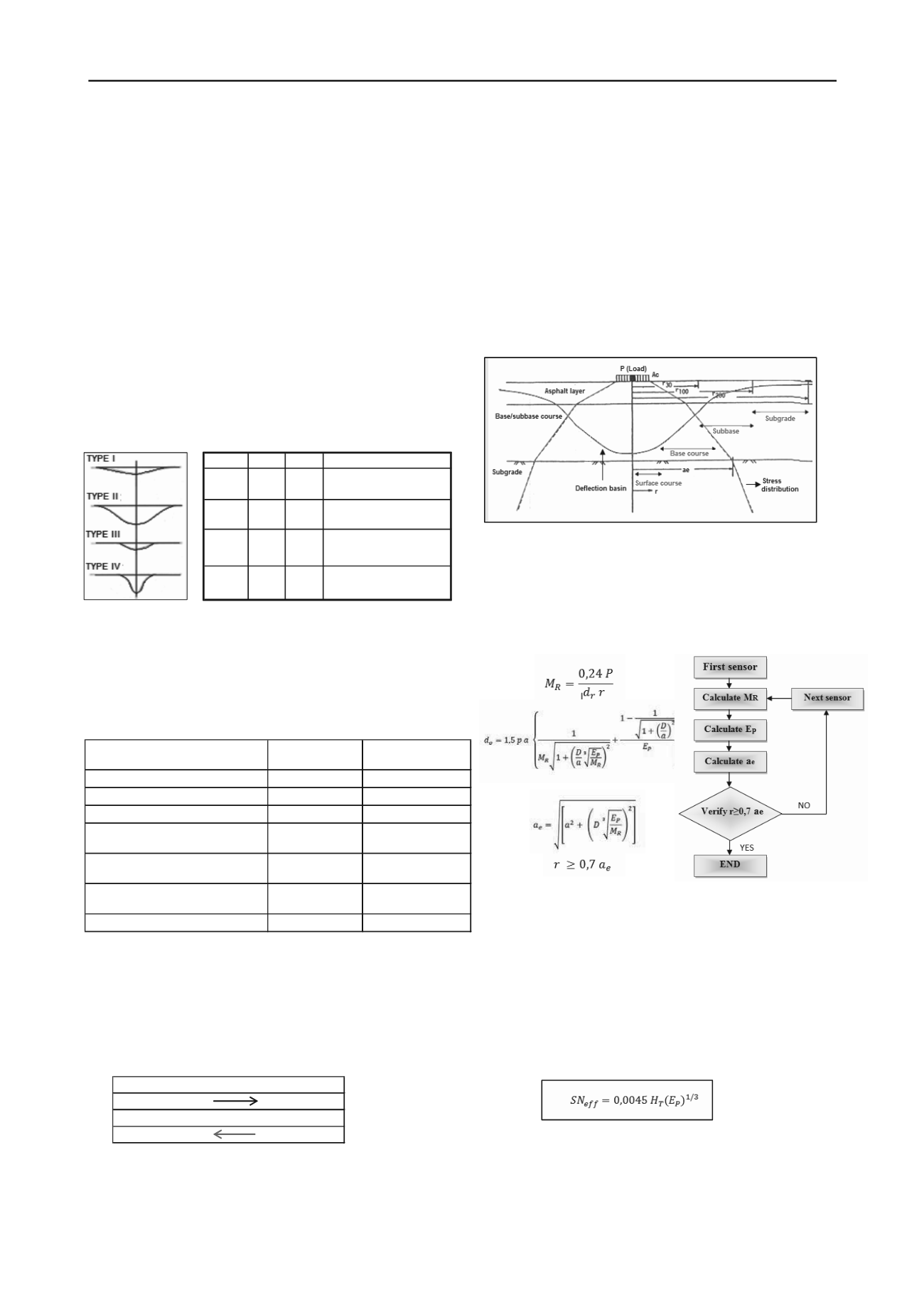
394
Proceedings of the 18
th
International Conference on Soil Mechanics and Geotechnical Engineering, Paris 2013
Therefore, it is important to determine the degree of correlation
between these two devices to be able to obtain FWD deflections
as a function of Benkelman beam deflections.
2
DEFLECTOMETRY
The deflection of an asphalt pavement structure is the vertical
displacement of the surface in response to application of an
external load. When this load is applied on the surface, all layers
are deflected, developing stress and strain in each layer, as shown
in Figure 1.
The shape and dimension of the deflection basin covers important
information about the structural characteristics of both the
pavement and subgrade. Deflections measured towards the end of
the basin reflect the condition of the subgrade, while the
measurements taken in the center of load application reflect the
condition of the surface layer.Figure1 shows the evaluation of the
pavement according to the length (Lo) and a maximum depth (Do)
of the basin.
Figure1.Characteristics of deflection basin
2.1Admissible deflection value
The maximum values of deflection for design purposes
estimated by Hveem (1995) are presented in Table 1.
Table 1. Maximum deflection values estimated by Hveem, 1995.
3
BACKCALCULATION METHODOLOGY
Table 2 shows the basics of back calculation methodology.The
back calculation outputs are the modulus of elasticity of the
pavement structure, effective structural number of the pavement
layers, and subgrade soil resilient modulus.
Table 2. Representation of back calculation methodology
whereE: elastic modulus of the materials, μ: Poisson's ratio, d:
deflection of the pavement structure, σ: stress on each layer of the
structure, ε: strain, and D: layers thickness.There are several
backcalculation methodologies, most of them carried out in
function of the deflections obtained only under dynamic load
including the AASHTO and SASW methodology which was used
for the analysis of the deflections obtained from FWD.( Murillo et
al, 2009).
There exist few methodologies developed from deflections under
static load, because these procedures do not simulate adequately
the real effects of moving loads. Mario Hoffman, in 1975,
presented a methodology based on the "Hogg Model", which was
used in the present study for backcalculation procedure based on
the deflections obtained using the Benkelman Beam.
Figure 2.Algorithm backcalculation of M
R
- AASHTO.
3.1.
AASHTO Methodology (for FWD)
The guide for designing of pavement structures AASHTO es-
tablishes a procedure to calculate the resilient module (M
R
)and
thereafter the effective structural number (pavement structural ca-
pacity) as shown in the flowchart of Figure 2.
whereMR: resilient modulus of the subgrade (psi), P: applied load
(pounds), r: distance from the center of the load (inch), d
r
:
deflection at a distance "r" from the center of the load (inch), a
e
:
radius of the bulb of pressure representing the subgrade level
(inch), a: radius of the loading Ring (inch), D: thickness of the
pavement structure above the subgrade (inch), Ep: equivalent
modulus of all pavement layers above the subgrade (psi), d
0
:
deflection at the center of the load plate, adjusted to a temperature
of 20
⁰
C (inch), p: pressure of load plate (P/πa2).The effective
structural number (SN
eff
) is calculated based on the total thickness
of the pavement and its effective modulus as shown below.
(1)
Type Do Lo
EVALUATION
I
Low High
Good subgrade soil/
Good pavement
II
High High
Poor subgrade soil/
Good pavement
III
Low Low
Good subgrade soil/Poor
pavement performance
IV High Low
Poor subgrade soil /Poor
pavement performance
Type of pavem structure
Thickness (mm)
Maximum deflection
value (microns)
Concrete pavement
200
300
Cement treated base
150
300
Asphalt pavement
100
425
Asphalt pavement
base course
(plant mixed)
75
500
Asphalt pavement on base course
(plant mixed)
50
625
Asphalt pavement on base course
(In‐situ)
25
925
Surface treatment pavement
13
1250
ent
on
DIRECT CALCULATION
E, Di,μ d,σ,ε
BACKCALCULATION
E
,σ,ε d, Di,μ


